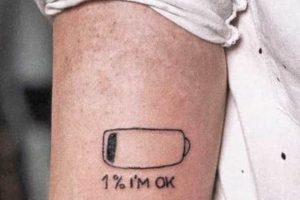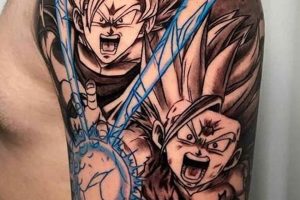Tattoos representing indigenous cultures encompass a wide range of styles and symbolism, often deeply connected to ancestry, spirituality, and natural elements. Designs may feature animals with cultural significance, traditional geometric patterns, depictions of ancestral figures, or symbols representing specific tribal stories and beliefs. For example, a tattoo might depict a bear, symbolizing strength and protection in some cultures, or incorporate intricate knotwork representing interconnectedness and lineage.
These designs offer a powerful way to express cultural pride and connection to heritage. They serve as a visual reminder of ancestral traditions and can contribute to the preservation of cultural narratives. Historically, tattoos played crucial roles in indigenous societies, signifying clan membership, marking rites of passage, or embodying spiritual beliefs. Today, they continue to hold deep meaning, offering individuals a tangible link to their roots and a means of expressing personal identity within a broader cultural context. Careful consideration of cultural sensitivity and appropriate representation is vital when exploring such designs.
Further exploration of this topic will delve into specific regional variations, the significance of various design elements, the importance of consulting with cultural experts and artists, and the ethical considerations involved in choosing culturally significant body art.
1. Cultural Significance
Cultural significance forms the foundation of indigenous tattooing traditions, imbuing designs with deep meaning beyond mere aesthetics. Understanding this significance is paramount for respectful engagement with these art forms. The following facets illustrate the intricate connection between cultural meaning and tattoo design:
- Ancestral Storytelling
Tattoos often serve as visual narratives, depicting ancestral stories, clan lineages, and historical events. Specific symbols and motifs represent key figures, mythical creatures, or significant moments in a culture’s history. For instance, Polynesian tattoos can depict genealogical information, tracing lineage back through generations. This visual storytelling preserves cultural memory and strengthens connections to the past.
- Spiritual Beliefs
Many indigenous cultures view tattoos as imbued with spiritual power. Designs may incorporate symbols representing deities, protective spirits, or elements of the natural world believed to hold sacred meaning. In some cultures, the act of tattooing itself is a ritualistic practice, connecting the individual to the spiritual realm. Certain symbols, such as the turtle in some Native American cultures, may embody longevity and connection to the earth.
- Social Markers
Tattoos can signify social status, clan affiliation, or achievements within a community. Specific designs or placements may denote a warrior’s prowess, a leader’s rank, or an individual’s role within the social structure. In some cultures, tattoos mark rites of passage, such as coming-of-age ceremonies, signifying transitions to new life stages. Intricate facial tattoos in Maori culture, for instance, communicate lineage and social standing.
- Connection to Nature
Indigenous cultures often hold a deep reverence for the natural world, reflected in their tattoo designs. Animal imagery, depictions of celestial bodies, and representations of plant life symbolize the interconnectedness of humans and nature. Specific animals may represent strength, wisdom, or other qualities associated with them within the culture’s belief system. Inuit tattoos might incorporate depictions of whales or bears, reflecting their importance in the Arctic environment.
These interconnected facets demonstrate that indigenous tattoos are far more than decorative markings; they are powerful expressions of cultural identity, embodying history, spirituality, and a profound connection to ancestral heritage. Approaching these designs with respect for their inherent meaning ensures their continued significance for future generations.
2. Symbiotic Relationship
A symbiotic relationship between the wearer and the culture represented in a tattoo is crucial for respectful and meaningful engagement with indigenous designs. This relationship necessitates understanding, reciprocity, and ongoing engagement with the culture, ensuring the tattoo’s significance is honored and perpetuated rather than appropriated. It moves beyond mere aesthetics and embraces the responsibility inherent in carrying a piece of another culture’s heritage.
- Respect for Cultural Heritage
Respect forms the cornerstone of the symbiotic relationship. It involves acknowledging the deep meaning embedded within indigenous designs and recognizing that these tattoos are not merely decorative but carry cultural weight. This respect extends to understanding the protocols and traditions surrounding tattooing within the specific culture. For example, in some cultures, certain designs are reserved for specific individuals or occasions, and it is essential to respect these customs.
- Reciprocity and Cultural Exchange
The symbiotic relationship involves a reciprocal exchange, where the wearer actively engages with the culture beyond the act of getting a tattoo. This could involve learning the language, supporting indigenous artists and communities, or participating in cultural events. This reciprocal engagement demonstrates a genuine interest in the culture and avoids the superficial adoption of symbols without understanding their context. Supporting indigenous artists directly contributes to cultural preservation and ensures that traditions are carried forward.
- Meaningful Engagement with the Design
Choosing a design based on genuine connection and understanding is paramount. Thorough research and consultation with cultural experts are essential for grasping the symbolism and significance of the chosen motif. This meaningful engagement ensures that the tattoo resonates with the wearer’s personal journey while also respecting the cultural narrative it represents. Simply copying a design without understanding its cultural context can be considered disrespectful and contributes to the trivialization of indigenous art.
- Ongoing Learning and Cultural Sensitivity
Cultural sensitivity involves a commitment to ongoing learning and understanding. Cultures are dynamic and evolve over time; therefore, continuous engagement with the culture’s traditions and practices is essential. This includes recognizing that meanings and interpretations may change, and being open to adapting one’s understanding accordingly. Participating in cultural events and engaging with indigenous communities fosters deeper understanding and strengthens the symbiotic relationship.
Cultivating this symbiotic relationship ensures that indigenous tattoo designs are not merely worn but embodied, reflecting a deep respect and appreciation for the culture they represent. This approach strengthens the connection between the individual and the cultural heritage, contributing to the preservation and celebration of indigenous art forms for future generations.
3. Authentic Representation
Authentic representation is paramount when considering tattoos inspired by indigenous cultures. It demands a deep understanding of the cultural context, symbolism, and traditions associated with the specific design. This approach avoids cultural appropriation, ensuring the tattoo honors the culture it represents rather than reducing it to a mere aesthetic trend. A lack of authentic representation can perpetuate harmful stereotypes, misrepresent cultural narratives, and erase the rich history embedded within these art forms. For example, wearing a headdress motif without understanding its significance within specific Native American cultures can trivialize a sacred object and disrespect its cultural meaning.
Achieving authentic representation requires thorough research and consultation with indigenous artists and communities. Collaborating with cultural experts ensures the design accurately reflects the intended symbolism and avoids misappropriation. This process also provides an opportunity to learn about the cultural protocols surrounding the design and the appropriate contexts for its display. Engaging directly with indigenous artists supports their work and contributes to the preservation of cultural heritage. Furthermore, understanding the historical evolution of designs and their contemporary interpretations within the culture adds depth and authenticity to the chosen tattoo. For instance, certain Polynesian patterns have specific meanings related to genealogy, status, or personal characteristics, and consulting with a Polynesian tattoo artist ensures accurate representation of these elements.
Authentic representation strengthens the connection between the individual and the culture represented in the tattoo. It fosters respect, understanding, and appreciation for indigenous art forms, contributing to their preservation and continued significance. This approach avoids the commodification of cultural symbols and ensures that tattoos inspired by indigenous cultures are worn with integrity and cultural sensitivity. The challenges lie in navigating the complexities of cultural exchange and ensuring respectful engagement with indigenous communities. Ultimately, prioritizing authentic representation honors the rich history and cultural heritage embedded within these powerful art forms.
4. Artist Collaboration
Collaboration with indigenous artists is essential when pursuing tattoos inspired by native cultures. This partnership ensures authentic representation, respects cultural protocols, and supports the continuation of traditional artistic practices. The artist’s expertise provides invaluable insight into the symbolism, historical context, and cultural significance of the chosen design. For example, a Haida artist can guide the design process for a Haida-inspired tattoo, ensuring the chosen elements accurately reflect clan crests, ancestral stories, or traditional artistic styles. This collaboration avoids misappropriation and ensures the tattoo honors the cultural heritage it represents. Furthermore, working with an indigenous artist directly contributes to the economic sustainability of indigenous communities and helps preserve cultural knowledge for future generations.
The collaborative process often involves in-depth discussions about the individual’s connection to the culture, their intentions for the tattoo, and the appropriate design elements to reflect those intentions. The artist may offer guidance on the placement, size, and style of the tattoo, ensuring it aligns with cultural norms and aesthetic principles. This dialogue fosters a deeper understanding of the cultural significance embedded within the design and empowers the individual to wear the tattoo with respect and knowledge. A Mori artist, for example, might discuss the wearer’s whakapapa (genealogy) to incorporate meaningful elements into a T moko design. This personalized approach strengthens the connection between the individual and the culture represented in the tattoo.
Prioritizing artist collaboration safeguards against cultural appropriation and promotes respectful engagement with indigenous art forms. It ensures that native tattoo designs are not merely copied but understood and appreciated within their cultural context. The challenges lie in finding and accessing indigenous artists, particularly for those who live outside of indigenous communities. However, the effort to establish these collaborations is crucial for ensuring authentic representation and supporting the continuity of cultural heritage. Ultimately, collaborating with indigenous artists is an investment in cultural preservation, fostering respect, understanding, and appreciation for the rich traditions of native tattooing.
5. Ongoing Learning
Ongoing learning is integral to respectful engagement with native tattoo ideas. Cultures are not static; they evolve, reinterpret traditions, and adapt to contemporary contexts. Therefore, acquiring a tattoo inspired by indigenous cultures necessitates a commitment to continuous learning about the culture’s evolving practices, beliefs, and artistic expressions. This ongoing engagement ensures the tattoo’s meaning remains relevant and respectful over time. For instance, the meanings attributed to certain symbols within a culture might shift over generations, and continuous learning allows individuals to understand these evolving interpretations. Ignoring this evolution risks misrepresenting the culture and perpetuating outdated or inaccurate information through the tattoo.
Practical applications of ongoing learning include staying informed about current discussions within indigenous communities regarding cultural appropriation, representation, and the appropriate use of traditional designs. Engaging with indigenous voices, attending cultural events, and supporting indigenous artists and scholars provide valuable insights into the evolving cultural landscape. For example, following the work of contemporary indigenous artists allows individuals to understand how traditional motifs are being reinterpreted and used in modern contexts. This active engagement demonstrates respect for the living culture and avoids reducing it to a fixed point in the past. It also allows individuals to adapt their understanding of their tattoo’s meaning as the culture itself evolves.
Ongoing learning fosters a deeper appreciation for the complexities of cultural heritage and ensures that native tattoo ideas are approached with humility and respect. The challenges lie in navigating the abundance of information available and discerning credible sources from misinformation. Prioritizing indigenous voices and engaging with reputable cultural institutions are crucial steps in this process. Ultimately, committing to ongoing learning ensures that native-inspired tattoos remain powerful symbols of cultural appreciation and respect, reflecting a dynamic and evolving relationship with indigenous heritage.
Careful consideration is essential when exploring tattoos inspired by indigenous cultures. The following tips offer guidance for navigating this complex process with respect and cultural sensitivity.
Tip 1: Research Thoroughly. Deepen understanding beyond superficial aesthetics. Explore the history, symbolism, and cultural protocols associated with specific designs and the cultures they originate from. For example, research the significance of specific animals in Northwest Coast Native American art before choosing a bear or raven design.
Tip 2: Consult Cultural Experts. Engage with indigenous artists, elders, and community members to ensure accurate representation and avoid misappropriation. Seek guidance on appropriate design elements and their cultural context. Contacting a local cultural center or museum can facilitate connections with knowledgeable individuals.
Tip 3: Prioritize Authentic Representation. Focus on honoring the culture’s heritage rather than simply adopting its aesthetics. Ensure the chosen design reflects genuine understanding and respect for its cultural significance. Avoid designs that trivialize or stereotype indigenous cultures.
Tip 4: Collaborate with Indigenous Artists. Commissioning a tattoo from an indigenous artist ensures cultural authenticity and supports indigenous communities. Their expertise guarantees respectful and accurate representation of cultural elements.
Tip 5: Understand Cultural Protocols. Recognize that certain designs may hold specific significance within a culture and should not be worn by outsiders. Respect cultural restrictions and avoid appropriating sacred or restricted symbols. Research the appropriate contexts for displaying certain designs.
Tip 6: Embrace Ongoing Learning. Cultures evolve, and understanding must evolve alongside them. Continuously engage with indigenous voices and perspectives to deepen understanding and ensure continued respect for cultural traditions.
Tip 7: Support Indigenous Communities. Beyond the tattoo itself, consider supporting indigenous artists, organizations, and cultural initiatives. This demonstrates genuine allyship and contributes to cultural preservation.
These guidelines empower individuals to approach native-inspired tattoos with respect, understanding, and cultural sensitivity. Adhering to these principles ensures that these powerful art forms are appreciated and honored for their rich cultural heritage.
By following these tips, individuals can contribute to a respectful and meaningful exchange between cultures, ensuring that native tattooing traditions are celebrated and preserved for future generations. This leads to a concluding discussion about the long-term impact of responsible engagement with indigenous art forms.
Frequently Asked Questions about Native-Inspired Tattoos
This section addresses common inquiries regarding tattoos inspired by indigenous cultures, offering guidance for respectful and informed decision-making.
Question 1: How can cultural appropriation be avoided when choosing a native-inspired tattoo?
Thorough research, consultation with cultural experts, and collaboration with indigenous artists are crucial. Focus on understanding the cultural significance of the design rather than simply appreciating its aesthetics. Avoid designs that are considered sacred or restricted within the culture.
Question 2: What is the significance of consulting with indigenous artists?
Indigenous artists possess the cultural knowledge and artistic expertise to ensure authentic representation. Their guidance ensures the chosen design aligns with cultural protocols and accurately reflects the intended symbolism. Collaborating with indigenous artists also supports their work and contributes to cultural preservation.
Question 3: Are all native-inspired tattoos considered cultural appropriation?
Not necessarily. Tattoos designed and applied by indigenous artists within their cultural traditions are expressions of cultural heritage. However, adopting designs without understanding their cultural context or appropriate permission can constitute cultural appropriation.
Question 4: How can one demonstrate respect for indigenous cultures when choosing a native-inspired tattoo?
Respect is demonstrated through thorough research, meaningful engagement with the culture, and ongoing learning. Supporting indigenous artists, communities, and cultural initiatives further demonstrates genuine appreciation and allyship.
Question 5: What are the ethical considerations involved in getting a native-inspired tattoo?
Ethical considerations include avoiding the appropriation of sacred or restricted symbols, ensuring accurate representation, and understanding the potential impact of the chosen design on indigenous communities. Ongoing learning and engagement with cultural experts are crucial ethical practices.
Question 6: What are some resources for learning more about specific indigenous cultures and their tattooing traditions?
Reputable museums, cultural centers, academic institutions, and books by indigenous authors offer valuable resources. Direct engagement with indigenous communities and artists provides firsthand insights and fosters respectful cultural exchange.
Respectful engagement with native-inspired tattoos requires ongoing learning, cultural sensitivity, and a commitment to honoring the rich heritage these designs represent. Careful consideration of these factors ensures that such tattoos serve as meaningful expressions of cultural appreciation rather than acts of appropriation.
This information provides a foundation for further exploration of specific cultural traditions and their unique approaches to tattooing. The following sections will delve into examples of native tattooing practices from various regions around the world.
Native Tattoo Ideas
Exploration of native tattoo ideas necessitates a multifaceted approach encompassing cultural significance, symbiotic relationships, authentic representation, artist collaboration, and ongoing learning. Designs rooted in indigenous traditions embody ancestral stories, spiritual beliefs, social markers, and profound connections to the natural world. Respect for cultural heritage requires more than mere aesthetic appreciation; it demands meaningful engagement, reciprocity, and continuous learning about the evolving cultural landscape. Collaboration with indigenous artists is paramount, ensuring accurate representation and supporting the continuity of cultural practices. Authenticity avoids the pitfalls of cultural appropriation, honoring the rich history and deep meaning embedded within these art forms.
Native tattoo ideas offer a powerful means of expressing cultural identity and connection to ancestral heritage. However, the responsibility inherent in carrying a piece of another culture’s history requires careful consideration, ongoing dialogue, and a commitment to respectful engagement. The future of these traditions relies on the ethical choices made by individuals and the collective effort to preserve and celebrate the rich tapestry of indigenous art forms for generations to come. Ultimately, the journey into native tattoo ideas is a path of continuous learning, cultural sensitivity, and deep respect for the heritage these designs represent.







